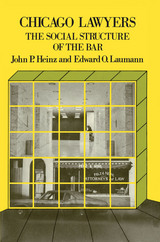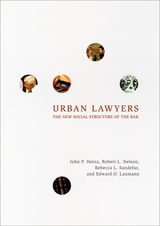3 books by Heinz, John P.

Chicago Lawyers
The Social Structure of the Bar
John P. Heinz
Russell Sage Foundation, 1982
What determines the systematic allocation of status, power, and economic reward among lawyers? What kind of social structure organizes lawyers' roles in the bar and in the larger community? As Heinz and Laumann convincingly demonstrate, the legal profession is stratified primarily by the character of the clients served, not by the type of legal service rendered. In fact, the distinction between corporate and individual clients divides the bar into two remarkably separate hemispheres. Using data from extensive personal interviews with nearly 800 Chicago lawyers, the authors show that lawyers who serve one type of client seldom serve the other. Furthermore, lawyers' political, ethno-religious, and social ties are very likely to correspond to those of their client types. Greater deference is consistently shown to corporate lawyers, who seem to acquire power by association with their powerful clients. Heinz and Laumann also discover that these two "hemispheres" of the legal profession are not effectively integrated by intraprofessional organizations such as the bar, courts, or law schools. The fact that the bar is structured primarily along extraprofessional lines raises intriguing questions about the law and the nature of professionalism, questions addressed in a provocative and far-ranging final chapter. This volume, published jointly with the American Bar Foundation, offers a uniquely sophisticated and comprehensive analysis of lawyers' professional lives. It will be of exceptional importance to sociologists and others interested in the legal profession, in the general study of professions, and in social stratification and the distribution of power.
[more]

The Hollow Core
Private Interests in National Policy Making
John P. Heinz, Edward O. Laumann, Robert L. Nelson, and Robert H. Salisbury
Harvard University Press
Critics of the policy-making process argue that private interest groups exert too much influence on the decisions of government, but only rarely has this proposition been examined systematically. The Hollow Core draws on interviews with more than 300 interest groups, 800 lobbyists, and 300 government officials to assess the efforts of private organizations to influence federal policy in four areas—agriculture, energy, health, and labor policy.
[more]

Urban Lawyers
The New Social Structure of the Bar
John P. Heinz, Robert L. Nelson, Rebecca L. Sandefur, and Edward O. Laumann
University of Chicago Press, 2005
Over the past several decades, the number of lawyers in large cities has doubled, women have entered the bar at an unprecedented rate, and the scale of firms has greatly expanded. This immense growth has transformed the nature and social structure of the legal profession. In the most comprehensive analysis of the urban bar to date, Urban Lawyers presents a compelling portrait of how these changes continue to shape the field of law today.
Drawing on extensive interviews with Chicago lawyers, the authors demonstrate how developments in the profession have affected virtually every aspect of the work and careers of urban lawyers-their relationships with clients, job tenure and satisfaction, income, social and political values, networks of professional connections, and patterns of participation in the broader community. Yet despite the dramatic changes, much remains the same. Stratification of income and power based on gender, race, and religious background, for instance, still maintains inequality within the bar.
The authors of Urban Lawyers conclude that organizational priorities will likely determine the future direction of the legal profession. And with this landmark study as their guide, readers will be able to make their own informed predictions.
Drawing on extensive interviews with Chicago lawyers, the authors demonstrate how developments in the profession have affected virtually every aspect of the work and careers of urban lawyers-their relationships with clients, job tenure and satisfaction, income, social and political values, networks of professional connections, and patterns of participation in the broader community. Yet despite the dramatic changes, much remains the same. Stratification of income and power based on gender, race, and religious background, for instance, still maintains inequality within the bar.
The authors of Urban Lawyers conclude that organizational priorities will likely determine the future direction of the legal profession. And with this landmark study as their guide, readers will be able to make their own informed predictions.
[more]
READERS
Browse our collection.
PUBLISHERS
See BiblioVault's publisher services.
STUDENT SERVICES
Files for college accessibility offices.
UChicago Accessibility Resources
home | accessibility | search | about | contact us
BiblioVault ® 2001 - 2024
The University of Chicago Press









